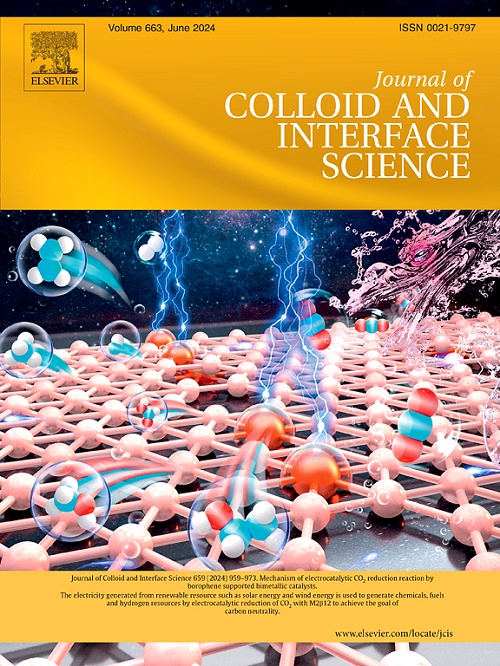碳毡上Co3O4纳米阵列的形态诱导空位工程实现了高性能钒液流电池
IF 9.4
1区 化学
Q1 CHEMISTRY, PHYSICAL
引用次数: 0
摘要
钒液流电池(VFBs)由于氧化还原动力学缓慢和质量传递效率低下,在功率密度方面面临着严峻的挑战。在此,我们提出了一种双重功能策略,通过前驱体形态学工程协同解决这两个限制。通过精确调节水热结晶动力学,碳酸氢氧化钴(CCH)前驱体从一维纳米棒演变为二维纳米片,退火后转化为Co3O4纳米阵列,同时保持结构特征。由此产生的一维棒状结构为离子快速扩散创造了开放的介孔通道,而富含氧空位的缺陷Co3O4表面增强了氧化还原动力学。DFT计算表明,氧空位使Co3O4的Co -能带中心上移,加强了钒离子的吸附,加速了氧化还原反应。有限元分析表明,棒状结构增强了质量输运,降低了浓度极化,而其均匀的电位分布抑制了寄生副反应。结果表明,含有Co3O4@CF-90的VFB在300 mA cm - 2时的能量效率高达74.4%,比传统碳毡高出9.7%,在200 mA cm - 2时的能量效率在400次循环中保持80.2%。这项工作为高性能液流电池电极、解耦催化和通过前驱体设计优化传输建立了可扩展的形态诱导空位工程范式。本文章由计算机程序翻译,如有差异,请以英文原文为准。

Morphology-induced vacancy engineering of Co3O4 nanoarrays on carbon felt enables high-performance vanadium flow batteries
Vanadium flow batteries (VFBs) face critical challenges in power density due to sluggish redox kinetics and inefficient mass transport. Herein, we propose a dual-functional strategy that synergistically addresses both limitations through precursor morphology engineering. By precisely regulating hydrothermal crystallization kinetics, cobalt carbonate hydroxide (CCH) precursors evolve from 1D nanorods to 2D nanosheets, which transform into Co3O4 nanoarrays after annealing while retaining structural features. The resulting 1D rod-like architectures create open mesoporous channels for rapid ion diffusion, while defective Co3O4 surfaces enriched with oxygen vacancies enhance redox kinetics. DFT calculations reveal that oxygen vacancies upshift the Co d-band center in Co3O4, strengthening vanadium ion adsorption and accelerating redox reactions. Finite element analysis demonstrates that the rod-like microstructure enhances mass transport and reduces concentration polarization, while its uniform potential distribution suppresses parasitic side reactions. As a result, the VFB with Co3O4@CF-90 achieves a high energy efficiency of 74.4 % at 300 mA cm−2, outperforming conventional carbon felt by 9.7 %, and maintains 80.2 % efficiency at 200 mA cm−2 over 400 cycles. This work establishes a scalable morphology-induced vacancy engineering paradigm for high-performance flow battery electrodes, decoupling catalytic and transport optimization through precursor design.
求助全文
通过发布文献求助,成功后即可免费获取论文全文。
去求助
来源期刊
CiteScore
16.10
自引率
7.10%
发文量
2568
审稿时长
2 months
期刊介绍:
The Journal of Colloid and Interface Science publishes original research findings on the fundamental principles of colloid and interface science, as well as innovative applications in various fields. The criteria for publication include impact, quality, novelty, and originality.
Emphasis:
The journal emphasizes fundamental scientific innovation within the following categories:
A.Colloidal Materials and Nanomaterials
B.Soft Colloidal and Self-Assembly Systems
C.Adsorption, Catalysis, and Electrochemistry
D.Interfacial Processes, Capillarity, and Wetting
E.Biomaterials and Nanomedicine
F.Energy Conversion and Storage, and Environmental Technologies

 求助内容:
求助内容: 应助结果提醒方式:
应助结果提醒方式:


